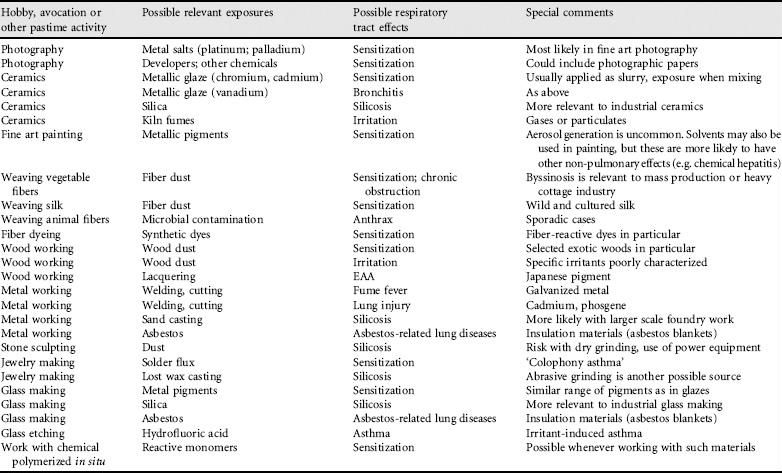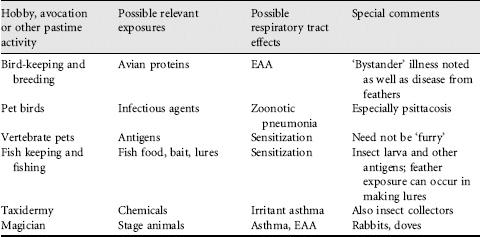7
Hobby pursuits
7.1 Definitions and general approach
Certain occupational/vocational activities are characterized variously as hobbies, pastimes, avocations or amateur undertakings. The respiratory health hazards arising out of these activities are heterogeneous, consistent with such a wide-ranging set of descriptors. For the sake of convenience, this group of pursuits will be referred to in this chapter collectively as ‘hobbies’, bearing in mind that no single word in current English usage adequately subsumes a full spectrum of activities that might be better captured by certain alternative terms. This is underscored by the differences in citations highlighted by a key word PubMed search using ‘pastime’ or ‘amateur’, as opposed to ‘hobby’, ‘hobbyist’ or ‘hobbies’.
Hobby pursuits are often home-based (although not necessarily transpiring indoors) and small-scale. Nevertheless, hobbies can also take place in a workshop or another location removed from one’s residence or in an environment that is completely outdoors and, rather than being small in scope, can approach the scale of an industrial prototype operation. By implication if not by definition, hobby activities are either unsalaried or recompensed on a freelance basis, but they need not be sporadic or infrequent, as any dedicated hobbyist can testify. Most importantly, these practices, no matter how they are labeled or where and how often they take place, potentially carry substantive risk of illness or injury. Such effects can target many organs, even though the focus in this chapter is on respiratory tract endpoints. As the above indicates, it is important that hobby activities be considered as possible factors in respiratory disease causation or aggravation.
Taking a hobby vocational history targeted to exposures and illnesses relevant to the respiratory tract may be considered either from the point of view of the type of activity involved, with its inherent risk factors, or from the disease endpoints that could be associated with the hobby in question. Although there is an obvious rationale in clinical practice in working backwards from the disease or symptom complex at hand to potential exposures, from a conceptual point of view it may be more helpful to first consider hobbies grouped by their potential exposure characteristics.
7.2 Arts, crafts, and related activities in the plastic arts
Activities that fall under this rubric are the most widely cited for their potential exposure risks relevant to occupational or environmental illness, even if objective evidence of adverse outcomes is limited to isolated case reports or, at most, fragmentary case series (Table 7.1). Nonetheless, it is obvious that certain substances that are employed in these hobby pursuits are so inherently dangerous that disease can potentially result, even if published documentation of such events is limited.
Table 7.1 Selected hobbies and other pastime activities with potential respiratory effects: arts, crafts and related plastic arts

Pigments used in painting, glazes employed in ceramics, and photographic emulsion salts share the potential for metal-related respiratory tract toxicity. Although lead is the most obvious metal toxic exposure arising from arts and crafts work, it is unlikely to be related to a disease presentation in which respiratory symptoms predominate (although shortness of breath could be a part of such a symptom complex in the event of severe anemia). Metal-associated sensitization leading to asthma or rhinitis is the most relevant respiratory disease mechanism for metals.
Such sensitization is most clearly the case with asthma among photographers due to platinum salts. Because platinum printing is almost always done by photographers preparing their own impregnated emulsions, this work process allows for potential sensitization and repeated re-challenge. Indeed, this is a process that is not available commercially and thus is limited to the self-employed artist or hobbyist (as broadly defined here). In addition to platinum-caused asthma, palladium is a related metal used in specialist photographic processes that could result in sensitization. Cobalt and chromium are metals that are used in paint pigments and glazes that can also act as sensitizers, although documented cases have been limited to industrial applications of these substances. Vanadium, another metallic coloring agent, is linked to chronic bronchitis in occupational studies.
This same group of crafts can certainly involve other exposures as well. Photographic work entails photographic developing chemicals that can act as respiratory sensitizers. Historically, photographically related printing techniques that entail intense light source exposure sometimes have employed carbon-arc sources that can generate rare earth exposures (a rare cause of pneumoconiosis). Ceramics work carries the potential for silica dust inhalation, particularly at stages in which dried, pre-fired pottery is manipulated. It is also important to clarify the nature and venting of an artisan’s kiln for firing. In addition to the potential evolution of irritant gas, certain firing techniques such as raku could generate particulate byproducts, a potential risk factor for chronic obstructive lung disease.
Fiber-based crafts center on the spinning of thread, weaving or other techniques to create a fabricated textile piece, and dyeing. Handling certain raw textile materials is associated with respiratory allergic sensitization, in particular work with silks (cultivated and wild). In contrast, the chronic lung diseases associated with industrial scale cotton and linen dust are unlikely to be linked to work done by a ‘hobbyist’ in the standard sense of the term. Nonetheless, it is important to remember that, in much of the world, fiber production is a cottage industry with home exposure the rule rather than the exception. This may be particularly relevant to certain syndromes, such as lung disease related to coconut husk fiber (coir) manipulation. Handling animal fibers, if imported through private unmonitored sources from anthrax-endemic areas, could lead to pulmonary infection. Dye handling is a route of potential respiratory sensitization, in particular through fiber-reactive dyes that are widely available to amateurs and professionals alike. Mention should be made of high couture fashion design and production as well, because this can involve exposure to exotic materials, including polymers with a strong propensity to cause asthma. Although this is hardly a ‘hobby’ undertaking, in principal it is an artisan-scale, prototype production process.
Fine wood working (including cabinet making, musical instrument production and other closely related pursuits) typically employs a range of common and exotic woods far more heterogeneous than standard commercial carpentry. Many of these are well-recognized respiratory tract sensitizers that can cause asthma and rhinitis (woods such as iroko, zebra wood and African cherry). Some woods also have irritant properties as well, although the medical literature on this subject is poor. In addition, woodworking can be glue and coating intensive, involving the use of acrylates, urethanes and epoxies with their inherent sensitizing risks. In Japanese lacquer making, extrinsic allergic alveolitis (EAA, also called hypersensitivity pneumonitis) has been associated with a mold-based pigment used to obtain a desirable black color. Although mold contamination of wood itself can also be a cause of EAA, this has been reported in industrial wood processing rather than fine crafts operations.
There are a number of other highly specialized artistic pursuits that could involve recognized risk factors for lung disease. Metal-working (e.g. metal sculpting or artisan blacksmithing) that employs any welding, brazing or flame cutting technique could be linked to a range of adverse respiratory effects, including metal fume fever (welding galvanized material), cadmium pneumonitis (flame cutting sheet metal or previously soldered joints), phosgene acute lung injury (by causing the breakdown of chlorinated solvent through heat or ultra violet light, as could occur through work with freshly degreased metals), or irritant-induced asthma (for example, due to combustion byproducts). Historically, the use of asbestos insulation materials (gloves, aprons, blankets) has been common in such endeavors. Metal casting (which involves silica and other exposures) on a scale used for most sculpture is done in commercial foundries and is not carried out by individual artists working in small workshops. Sculpting in stone can generate considerable silica dust, even if done on a small scale, especially if performed using dry power equipment.
Jewelry making can be linked to solder flux (colophony) exposure, a known cause of asthma, or silica, either through small-scale sand casting (e.g. ‘lost-wax’ process) or from abrasive wheel grinding dust exposure. Glass working can involve all of the pigments previously addressed above in relation to pigments and glazes in painting and ceramics; silica (especially in grinding or in sandblast etching); and hydrofluoric acid in certain etching techniques (as a risk of irritant-induced asthma). In addition, because of the heat sources used, glass-making has the same asbestos issues as metal-working.
Over and above the ‘traditional’ media delineated above, in the twenty-first century, sculptors, jewelry-makers and other visual artists have access to a full range of synthetic chemicals, including solvents and specialty polymers, sometimes even industrial-strength products that would not normally be available to general consumers, but which could have adverse respiratory effects that are difficult to predict.
7.3 Hobbies and pastimes involving pets and other animals
Keeping a common pet or even several pets is such a widespread activity that it is generally not considered a hobby or even a particular pastime, although taking a history of common pet ownership is certainly recommended in the evaluation of asthma triggers (both for cause of disease onset and aggravation of existing disease). Factors that tip the balance from ‘routine’ pet ownership to a hobby pursuit and that may increase the index of suspicion as an asthma trigger or expand the differential diagnosis to other conditions include the number of ‘pets’ kept and the location in which they are kept (increasing the exposure frequency and intensity), the type of animal involved (for example, avian as opposed to mammalian) and the activities involved in the hobby (for example, feeding pets using antigenic substances, grooming and cage cleaning or even sterilizing, or participating in competitive pet shows or other events).
Bird keeping (pigeon-raising in particular) is the most well-studied and best documented pet-related hobby in the medical literature because of its causative role in EAA (bird-fancier’s lung and related terms) (Table 7.2). Pigeons are important because they are raised in numbers for sport (racing) and are frequently housed in close quarters (dove-cotes or coops are typically separate from human living quarters) where exposure levels are high (endemically with cleaning coops; with seasonal variation when pigeons molt in the fall). Single or only a few household birds can also be a potent risk factor for EAA, especially budgerigars (an Australian parakeet particularly popular in the UK), canaries, parrots and love birds. An important aspect of birds kept in the home is that ‘bystander’ illness can also occur among members of the household other than the pet-owner, thus asking about the hobbies of others is relevant, not simply the index case of disease. Moreover, exposure to feathers can also lead to disease; such exposures can be linked to hobbies other than bird-keeping, such as fabricating fishing lures.
Table 7.2 Selected hobbies and other pastime activities with potential respiratory effects: animal contact

Stay updated, free articles. Join our Telegram channel

Full access? Get Clinical Tree


